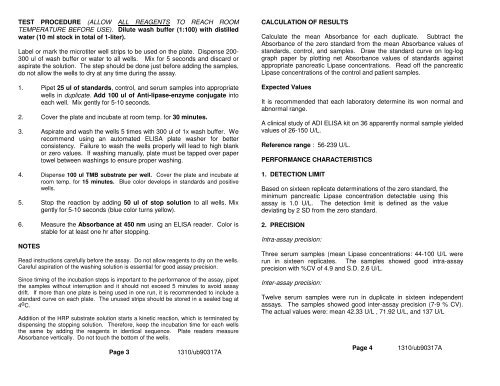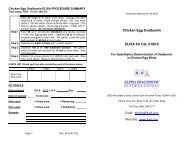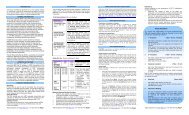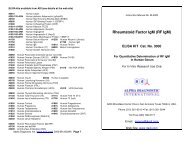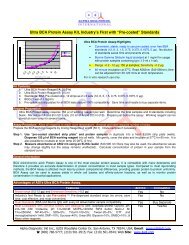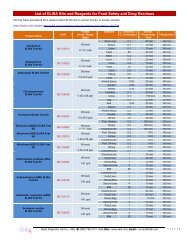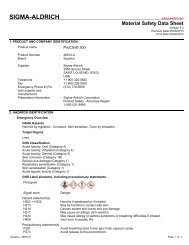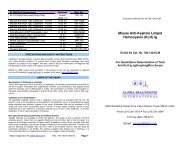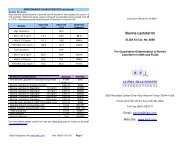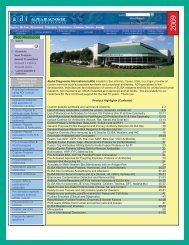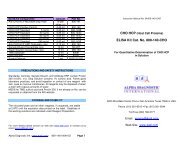Human Pancreatic Lipase
Human Pancreatic Lipase
Human Pancreatic Lipase
Create successful ePaper yourself
Turn your PDF publications into a flip-book with our unique Google optimized e-Paper software.
TEST PROCEDURE (ALLOW ALL REAGENTS TO REACH ROOMTEMPERATURE BEFORE USE). Dilute wash buffer (1:100) with distilledwater (10 ml stock in total of 1-liter).Label or mark the microtiter well strips to be used on the plate. Dispense 200-300 ul of wash buffer or water to all wells. Mix for 5 seconds and discard oraspirate the solution. The step should be done just before adding the samples,do not allow the wells to dry at any time during the assay.1. Pipet 25 ul of standards, control, and serum samples into appropriatewells in duplicate. Add 100 ul of Anti-lipase-enzyme conjugate intoeach well. Mix gently for 5-10 seconds.2. Cover the plate and incubate at room temp. for 30 minutes.3. Aspirate and wash the wells 5 times with 300 ul of 1x wash buffer. Werecommend using an automated ELISA plate washer for betterconsistency. Failure to wash the wells properly will lead to high blankor zero values. If washing manually, plate must be tapped over papertowel between washings to ensure proper washing.4. Dispense 100 ul TMB substrate per well. Cover the plate and incubate atroom temp. for 15 minutes. Blue color develops in standards and positivewells.5. Stop the reaction by adding 50 ul of stop solution to all wells. Mixgently for 5-10 seconds (blue color turns yellow).6. Measure the Absorbance at 450 nm using an ELISA reader. Color isstable for at least one hr after stopping.NOTESRead instructions carefully before the assay. Do not allow reagents to dry on the wells.Careful aspiration of the washing solution is essential for good assay precision.Since timing of the incubation steps is important to the performance of the assay, pipetthe samples without interruption and it should not exceed 5 minutes to avoid assaydrift. If more than one plate is being used in one run, it is recommended to include astandard curve on each plate. The unused strips should be stored in a sealed bag at4 o C.Addition of the HRP substrate solution starts a kinetic reaction, which is terminated bydispensing the stopping solution. Therefore, keep the incubation time for each wellsthe same by adding the reagents in identical sequence. Plate readers measureAbsorbance vertically. Do not touch the bottom of the wells.Page 3 1310/ub90317ACALCULATION OF RESULTSCalculate the mean Absorbance for each duplicate. Subtract theAbsorbance of the zero standard from the mean Absorbance values ofstandards, control, and samples. Draw the standard curve on log-loggraph paper by plotting net Absorbance values of standards againstappropriate pancreatic <strong>Lipase</strong> concentrations. Read off the pancreatic<strong>Lipase</strong> concentrations of the control and patient samples.Expected ValuesIt is recommended that each laboratory determine its won normal andabnormal range.A clinical study of ADI ELISA kit on 36 apparently normal sample yieldedvalues of 26-150 U/L.Reference range : 56-239 U/L.PERFORMANCE CHARACTERISTICS1. DETECTION LIMITBased on sixteen replicate determinations of the zero standard, theminimum pancreatic <strong>Lipase</strong> concentration detectable using thisassay is 1.0 U/L. The detection limit is defined as the valuedeviating by 2 SD from the zero standard.2. PRECISIONIntra-assay precision:Three serum samples (mean <strong>Lipase</strong> concentrations: 44-100 U/L wererun in sixteen replicates. The samples showed good intra-assayprecision with %CV of 4.9 and S.D. 2.6 U/L.Inter-assay precision:Twelve serum samples were run in duplicate in sixteen independentassays. The samples showed good inter-assay precision (7-9 % CV).The actual values were: mean 42.33 U/L , 71.92 U/L, and 137 U/LPage 41310/ub90317A


